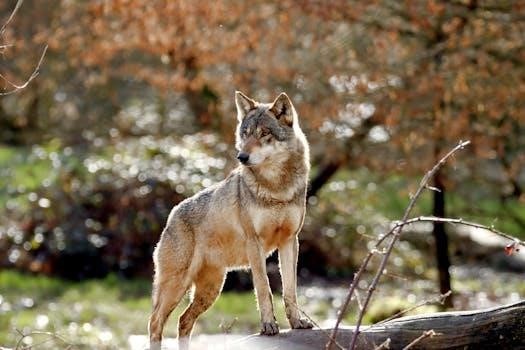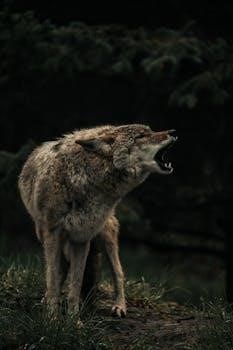
wolf leader guide
Wolf packs are highly organized social units with a clear leadership structure. They function as a family, with roles and responsibilities defined by a hierarchy. Understanding this structure is key to understanding wolf behavior.
Understanding Wolf Pack Social Structure
Wolf packs are not just random groups of wolves; they are cohesive social units with a well-defined hierarchy. This structure is crucial for their survival and well-being. The pack typically consists of a breeding pair, their offspring, and sometimes other related individuals. Each member has a specific role within the pack, contributing to the overall success of the group. This social organization facilitates cooperation in hunting, raising pups, and defending their territory. The hierarchy isn’t always rigid and can be influenced by factors such as age, experience, and the number of wolves in the pack. This dynamic ensures the pack’s adaptability and continued existence.
The Alpha Pair⁚ Core Leadership
At the heart of the wolf pack lies the alpha pair, the breeding male and female. They are the leaders, responsible for the pack’s overall direction and safety.
Roles and Responsibilities of the Alpha Male
The alpha male is the dominant wolf and leader of the pack, holding the highest rank. He is typically the strongest, wisest, and most experienced male. His responsibilities include leading hunts, choosing prey, and eating first. He also plays a crucial role in ensuring the pack’s safety and making decisions that affect the pack’s survival. The alpha male is not always the largest wolf, but he commands respect and maintains order within the pack through his actions and experience. He is the primary decision-maker for the pack’s activities, ensuring the group’s overall well-being. In short, he is the protector and provider.
Roles and Responsibilities of the Alpha Female
The alpha female is a crucial leader within the pack, often working in tandem with the alpha male. She plays a significant role in maintaining order and leading the pack, especially concerning reproduction. The alpha female is usually the breeding female, responsible for producing pups, and subsequently, plays a vital role in their early care and development. She helps manage pack dynamics and has a high level of influence on daily activities. The alpha female is a strong and capable leader, equal in importance to the alpha male, and together they ensure the pack’s survival. Her role goes beyond just motherhood.

Other Ranks Within the Pack
Beyond the alpha pair, wolf packs include other important roles. These include beta wolves, mid-ranking wolves, and the omega wolf, each with their own specific functions within the pack.
The Beta Wolf⁚ Second-in-Command Role
The beta wolf often acts as the second-in-command within the pack, supporting the alpha pair. This role is typically held by a male, but can sometimes be a female. The beta’s responsibilities include assisting with hunting, maintaining pack order, and helping to raise pups. They are usually the next in line to assume the alpha role, should the current alpha be unable to continue, thus ensuring the pack’s stability. While not the ultimate decision-maker, the beta wolf wields considerable influence and serves as a vital link in the pack’s leadership structure. Their presence provides support and a backup system for the alpha pair. In some cases, they may be a sibling or a close relative of one of the alphas.
Mid-Rank Wolves and Their Functions
Mid-rank wolves form the majority of the pack and fulfill essential roles in its daily life. These wolves are typically the offspring of the alpha pair or other related individuals. They contribute to hunting, pup-rearing, and defending the pack’s territory. While they do not have the authority of the alpha or beta wolves, mid-rank wolves are crucial for the pack’s success. Their position in the hierarchy is fluid, with some individuals occasionally showing dominance over others. They generally follow the lead of higher-ranking wolves but still contribute to decision-making and provide the necessary labor. Their participation ensures pack stability and resource access.
The Omega Wolf⁚ The Lowest Rank
The omega wolf occupies the lowest rank in the pack hierarchy, often misunderstood as a position of weakness. While they are often the last to eat and may face aggression from other pack members, the omega wolf plays a vital role. They act as a scapegoat, absorbing tension and aggression within the pack, which helps maintain stability and cohesion. Their presence also allows other wolves to practice dominance displays without serious conflict. Omega wolves are not necessarily physically weak but are simply subordinate in the social structure, contributing to the pack’s overall harmony by taking on this role.

Dynamics of Wolf Pack Hierarchy
The hierarchy within a wolf pack is not static; it is fluid and ever-changing. Dominance is established and maintained through displays of both dominance and submission among pack members.
How Dominance is Established and Maintained
Dominance in a wolf pack is not solely about physical strength. It is a complex interplay of factors including experience, wisdom, and social skills. Wolves establish their position through displays of dominance, such as body language, vocalizations, and controlled aggression. These displays are crucial for maintaining order and minimizing conflict within the pack. Submissive behaviors, like lowering the head or tail, also play a critical role in reinforcing the hierarchy. While physical confrontations can occur, they are typically brief and ritualized to avoid serious injury. The established hierarchy helps to minimize internal strife and ensures that the pack functions cohesively, especially during hunts and raising pups. Thus, the social structure is constantly being negotiated and reaffirmed through various forms of interaction.
The Fluid Nature of Wolf Pack Rankings
Wolf pack rankings are not static; they are dynamic and can change over time. The hierarchy isn’t a rigid structure. It’s influenced by factors such as age, health, and individual abilities. An older, weaker wolf may relinquish its position to a younger, stronger individual. Challenges to the established order can occur, especially during periods of stress or change. The arrival of new wolves, such as pups reaching maturity or outside wolves joining, can also cause shifts in the hierarchy. These fluctuations in rank reflect the evolving needs and capabilities of the pack as a whole. The ability of a wolf pack to adapt and change within its structure contributes to its survival and success, demonstrating the dynamic nature of wolf society.

Dispelling Myths About Alpha Wolves
The idea of an “alpha” as a ruthless dictator is a misconception. Wild wolf packs are led by breeding parents, not by a constantly battling dominant wolf as often portrayed.
Challenging the Traditional Alpha Concept
The traditional concept of an alpha wolf, constantly fighting for dominance, stems from studies of captive wolves, which do not accurately represent wild wolf pack dynamics. In nature, leadership is more about parental roles and breeding rights than brute force. Dominance contests are rare among family members, the core of most wolf packs. The term “alpha” often emphasizes a dominance hierarchy, but in wild packs, the so-called alpha male and female are simply the breeding pair. Their status is not maintained through constant aggression; it is a natural part of family structure. The idea of a merciless leader is a myth perpetuated by misinterpreted research. The focus should be on the cooperative nature of wolf packs.

Formation and Stability of Wolf Packs
Wolf packs form through various means, including dispersal of individuals, group dispersal, and pack splitting. Factors like births, deaths, and resources influence the stability and size of these packs.
How Wolf Packs Are Formed
In most wolf populations, a new pack begins when a lone female pairs with a solitary male, establishing a new family unit. However, in areas with high wolf density, options for finding an unoccupied territory are limited. New packs can also emerge through group dispersal, where multiple wolves leave their original pack together, sometimes joining unrelated wolves from other packs. Additionally, pack splitting can occur when a portion of an existing pack breaks off to form a new, independent group. These processes shape the dynamic nature of wolf populations and their social structures, demonstrating adaptability in varied environments.
Factors Affecting Pack Structure and Size
Wolf pack size and structure are influenced by several factors. The availability of prey is crucial; areas with abundant prey tend to support larger, more complex packs. Birth rates, dispersal patterns, and mortality rates, whether from disease, territorial conflicts, or human activities, also significantly affect pack dynamics. Furthermore, the presence of multiple breeding pairs can contribute to larger, extended family groups. These factors create a complex interplay that shapes the size and composition of wolf packs, leading to variations across different populations and environments, highlighting the adaptive nature of these social units.


Leave a Reply
You must be logged in to post a comment.